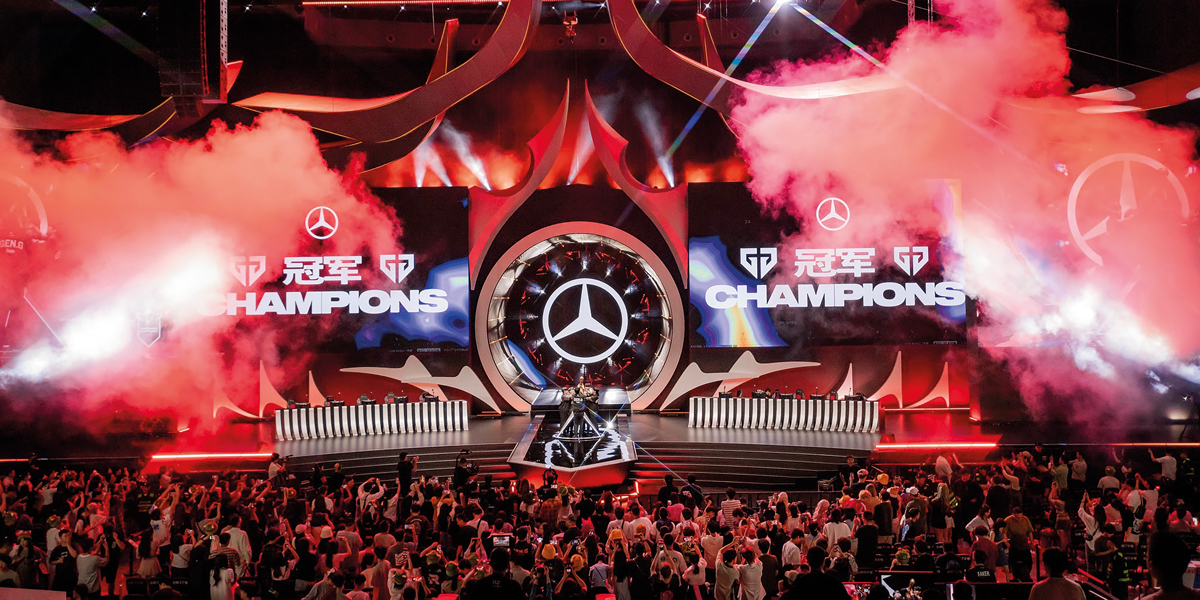Raising the Live Broadcast Bar

Posted on Aug 14, 2024 by FEED Staff
Pioneering the intersection of esports gameplay and live broadcast production, organisers are elevating technology to the top tier
Words by Fergal Ringrose
Riot Games took centre stage at the 45th Annual Sports Emmy Awards in late May, winning the Sports Emmy for outstanding esports championship coverage.
This prestigious accolade was awarded for the developer’s coverage of the League of Legends Worlds 2023 Final, held in November of 2023 at the incredible Gocheok Sky Dome in Seoul, South Korea.
Riot’s annual World Championship for League of Legends esports has consistently scored nominations from the Academy since the category’s inception in 2020. This year marked Riot’s fifth win at the awards, having triumphed over its stablemate, the Valorant Champions 2023 Grand Final and fellow nominees: the 2023 Call of Duty League Championship Weekend; ESL Faceit Group’s Intel Extreme Masters Cologne 2023 Grand Finals; and Blast’s Blast.tv Paris Major 2023.
No live production sector has pushed the boundaries of tech over the past decade more than esports, which has persistently produced a unique fan experience. From virtual production and augmented reality (AR) to AI and machine learning, esports productions in competitive online gaming eagerly embrace and enhance innovative advances.
As esports grow in popularity, tournament producers face the challenging task of creating the most immersive experiences to keep their huge fanbase engaged. Through in-game replays, content management, disruptive live switching and digital publishing, technology helps producers bring live storytelling of the highest standards to informed and passionate audiences.
Producers are not constrained by the limitations of traditional sports coverage. In the digital-native games ecosystem, everything can or should be augmented, enhanced, explained and shared across platforms instantly. A key factor setting esports apart from traditional broadcast is the viewing medium; much of the content is consumed via mobile and digital devices. In esports, the traditional TV lean-back is not the predominant viewing experience. Immersive audio is, to date, not a feature of esports owing to distribution platforms.
The way viewers consume esports is unique: mobile or PC screen and on platforms like Twitch and YouTube. Esports organisations embed these streams into their websites, where fans can earn in-game rewards. In-game cameras are directed by observers, who are the storytellers – former professional players with intimate knowledge to tell the story. The creators and producers should always seek to work closely with the observers. Good observers tell the story, while show producers provide them with triggers to populate graphics and switchers.
Esports organisers have pioneered AR by streamlining Unreal Engine to control immersive environments in real time. The engine empowers producers to blend live action with immersive graphics, while AI tracks in-game statistics like win percentages. AR and AI have become integral in processing and visualisation to deliver heightened experiences, supported by a shift from bespoke hardware to the more flexible CPU and GPU space, allowing greater creativity for esports producers.
A key hurdle esports tournament organisers face is that a large portion of the audience watch through various streaming services, rather than being in the stadium. In contrast to traditional sports, there are no external TV crews from sports channels present, so the organisers must carefully plan and produce the event themselves.
For esports events, having multiple diverse fibre connections in and out of the venue is imperative to guard against any potential internet faults or outages. For large events, production organisations typically have their own systems integration and engineering teams to ensure smooth operations.
Whereas in traditional sports, the ‘team in the truck’ focuses on cameras and replays covering the field of play, esports production must also present what is happening within the game. This is why the observers, who change camera angles in-game, are so critical and unique to this genre.
All the tools of traditional sports broadcasting are important, but in esports, the added complication is automation. Producers need multiple events, triggers and cues to manage the huge amount of data generated in a virtual environment. This automation is typically a combination of signals around in-game data, triggering cues and automatic feeds. For example, during a time-out, cues for music and other elements are entirely automated.
Behind the scenes at IEM
In a recent company blog, Ross Video marketing manager Paul Seymour took us behind the scenes of ESL Faceit Group’s Intel Extreme Masters (IEM) Cologne 2023 Grand Finals, stating, “Part of the magic of live events is that the audience doesn’t realise there is another show going on behind the scenes: a secret and carefully synchronised dance which brings the show on stage to life.
“The coordination required by production crews is worthy of an audience itself. From the technical director and replay operators to the content managers, graphics playback teams and broadcast engineers who bring it all together – the show’s success hinges on their perfectly synchronised teamwork.
“In the realm of esports, the challenge is even more significant. The presentation of real-time statistics during a live event is vital to delivering a compelling story to fans. However, the lightning-fast pace of esports is too quick for operators to provide integrated statistics and graphics in real time. So, what does the control room dance look like for a premier esports event?”
“Last August, the IEM returned to Cologne and esports fans descended upon the Lanxess Arena for the final three days of the competition dubbed The Cathedral of Counter-Strike,” Seymour continues. “This significant event in the esports calendar draws a sizeable live audience and over 700,000 fans online to watch the world’s top Counter-Strike: Global Offensive (CS:GO) teams compete.
“IEM and EFG entrusted Rocket Surgery – Ross Creative & Professional Services with adding AR to enhance the production and immerse the audience and fans at home deeper into the action. For XPression and Voyager customers in video, broadcast and venue production, Rocket Surgery provides design, workflow and data integration expertise,” he elaborates.
“Rocket Surgery accomplished this through a combination of Ross AR technology, including the Voyager Unreal-based render platform, Ultrix routers, a Carbonite Ultra production switcher and an Opengear frame paired with various signal processing cards. Complementing this array of production room technology was the use of the Spidercam cable-based camera system to provide unique visuals and feed the tracking data required to power the AR visuals.
“To address the hurdle presented by the rapid pace of online gameplay, Ross introduced a tailored solution, combining Dashboard and Datalinq to integrate all their video game APIs and devices directly into the production workflow,” Seymour adds. “This allowed Rocket Surgery experts to programme the custom Dashboard control panel using the Rosstalk protocol, enabling operators to manage the whole system efficiently and automatically merge inputs and data with AR graphics in real time. Automating the integration of real-time statistics into immersive AR graphics allows IEM to keep esports fans well-informed and elevate the entertainment value of the show without additional operators.”
Running Riot
In late 2023, Riot Games opened its second Remote Broadcast Centre (RBC) in Seattle. Earlier in the year, it announced a partnership with Gravity Media (now EMG/Gravity Media after a January 2024 merger) to provide managed services for the Seattle RBC, following the delivery of a similar solution at Riot’s first RBC in Dublin. There, EMG/Gravity Media placed 40 individuals across broadcast engineering, TOC, EVS, audio GFX and media asset management.
The 70,000 sq ft production space – located 16 miles south of Seattle – is Riot’s second RBC strategically placed around the globe to support regional and global live esports events. The 2023 Valorant Game Changers Championship, which took place in December from Riot’s esports studio in São Paulo, Brazil, was the first live global esports event supported by the Seattle area RBC. Courtesy of Riot’s partnership with Amazon Web Services (AWS), six control rooms are outfitted with new technology and cloud-based zero client computing, enabling Riot to efficiently produce events more virtually and remotely than before.
Both production facilities are using Appear’s X Platform for events such as the League of Legends and Valorant Champions Tour. X Platform facilitates video networking, enhanced IP security and advanced compression for remote production, contribution and distribution.
Its SMPTE 2110-native connectivity for AVC/HEVC encoders in addition to decoders, with SMPTE 2022-7 and NMOS support, enabled Riot to migrate from its previous SDI-only solution. Riot will continue to use X Platform to support high-capacity remote productions using transport stream over IP (TSoIP) with FEC and SRT gateways where needed to support different network types.
Riot has been a proud customer of Nevion, a Sony Group Company, since 2019. During this time, it has deployed Nevion VideoIPath orchestration and Virtuoso with JPEG XS compression to build its global follow-the-sun remote production approach to producing tournaments and events from any of its facilities. This year, the company installed Sony’s MLS-X1 modular live switcher and expanded its use of VideoIPath for broadcast control. It also added a federation of resources designed to enable orchestration systems to collaborate within and between locations using Sony’s Networked Live ecosystem.
Dreamhack in Dallas
Dreamhack is a global series of gaming lifestyle festivals including Tier 1 esports tournaments, variety programming, an expo floor, art, music and much more. It is an ESL Gaming brand specialising in esports tournaments and other gaming conventions. The series is recognised by the Guinness World Records and Twin Galaxies as the world’s largest LAN party and computer festival with the world’s fastest internet connection and most generated traffic.
The latest event – Dreamhack Dallas – took place in June 2024, where gamers from all backgrounds connected for a weekend of esports, cosplay creator-led activities, panels and workshops. Esports Engine, now part of the ESL Faceit Group following a merger in 2023, orchestrated the festival’s esports broadcasts alongside ESL’s production team.
Esports Engine works with gaming publishers, rightsholders, brands and teams to contribute production, broadcast, tournament and programme design. In recent years, the company has worked with ESL Pro Tour, Fortnite World Cup, Halo Championship Series, Forza Championship, MLG CS:GO Major, X Games and Rocket League Championship Series.
At the SVG Esports Production Summit in 2023, Esports Engine co-founder and chief production officer Ryan Thompson said: “It’s been a wild year. At the start of the year, we came together with EFG, and we’ve spent that time doing not only several esports events but meeting much of the 1500 workforce there. When working with Esports Engine, we were slowly growing and knew what the endgame was there.
“The best thing is we’re finding like-minded production and creatives; at the end of the day, people who just want to make great esports, with the ability to continue realising the mission of Esports Engine to be a force for good – but we still have a lot of work to do. There are ups and downs in the world of esports, and we’re the ones who must navigate that.
“But now, we have access to global distribution and so much technical expertise, we can commit to do all the events for next year. Now, we can take giant steps forward with technology,” enthused Thompson.
“We have a plethora of sound stages and studios, but it’s difficult for me to go to a client and say: ‘You should spend a lot of money on this big fancy set and then fly all the players out for a qualifier event.’ Again, it’s about sustainability in esports, and we need to have the right scale of production for the right time. Luckily, we can do every scale; we boast some shows with two people on the crew and other shows with 200. We really have it all.
“We also have to be honest about where we’re at. Some years are up, some years are down. If we don’t get the right scale of production, have the wrong-sized workforce or make the incorrect recommendations to our clients, there simply won’t be clients,” he admitted.
“Our mission was to be a force for good in esports and we’re carrying that forward with EFG, integrating with them. We want esports to exist and thrive, but this will only happen if it’s sustainable. Success hinges on a business model with return on investment alongside authenticity with both the players and the community. It’s certainly a tough puzzle to figure out, but when the dust settles, we’re still here. We have been figuring it out for more than 20 years, and we will continue to figure it out moving forward,” concluded Thompson.
This feature was first published in the Summer 2024 issue of FEED.









